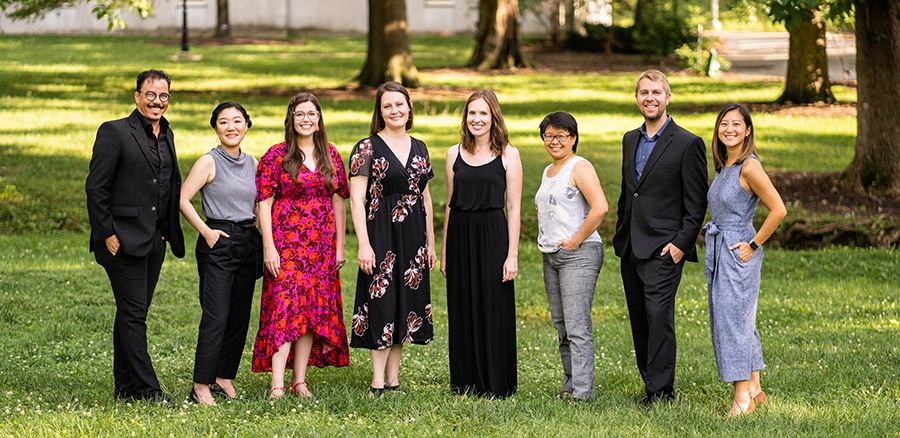Meet the Grantees: Khemia Ensemble
One of CMA's 2023 Classical Commissioning grantees

With members living in six different states, spanning three time zones, and all teaching at the collegiate level, Khemia Ensemble continues to pioneer and shape the frontier of the contemporary classical chamber music scene. Currently in their ninth season, Khemia uses their dynamic instrumentation—soprano, flute, clarinet, violin, cello, piano, and two percussionists—to expand what “chamber music” means, especially as they have commissioned and premiered more than 60 works for their mixed instrumentation. In addition to performing nationwide, Khemia values educating future composers and musicians, having held multiple artist residencies across North and South America and offering workshops and reading sessions for student/emerging composers and masterclasses for vocal and instrumental students.
With the deadline for CMA’s 2024 Classical Commissioning grant program fast approaching, CMA staffer Ben Schonhorn asked Khemia to share more about the ensemble’s history, their dedication to commissioning new music, how they balance their personal musical successes with the ensembles, and how it’s been working with Anuj Bhutani for their upcoming project, funded with support from the Classical Commissioning program.
How did Khemia Ensemble get its start?
The idea of forming Khemia started in the summer of 2014, when composer Carolina Heredia, vocalist Amy Petrongelli, and clarinetist Thiago Ancelmo met at the New Music on Point in Vermont. In 2015, Carolina gathered the rest of the ensemble, and we embarked on a South American Tour to Colombia and Argentina. After the tour, we talked and decided to invest in this project. From the beginning, one challenge was finding efficient ways to optimize our rehearsal time. At the start of our second season, group members began getting jobs in different states, which limited how often the ensemble could meet. This led us to create a series of procedures that we go through before our rehearsals, which has proved to be very effective for us.
Has Khemia always been an eight-person ensemble? I can imagine that getting all members in the same room is quite the challenging feat.
When the group gave its first performance in 2015, Khemia had 11 members: three-composers-in-residence, soprano, flute, clarinet, bassoon, violin, cello, piano and percussion. Soon, the group evolved into a Pierrot ensemble (sop, fl, cl, vln, vcl, and pno) plus two percussionists. Adding two percussionists to the Pierrot instrumentation has helped expand our sound palette and it offers up large instrumentation possibilities for commissions! We try to perform as the full eight-person ensemble as much as we can, and we have a very colorful shared calendar to try to schedule performances as far in advance as possible. Still, exploring performance opportunities in smaller subsets of the ensemble has helped vary our programming and maximize rehearsal times.
How has it been working with Anuj Bhutani? What can you tell us about the work you are collaborating on and the process of it?
It’s been fantastic so far! We first learned about Anuj when he applied to Khemia’s first-ever Commission Contest in 2022. We knew we wanted to work with him again in the future and we were thrilled when he agreed to apply to CMA’s Classical Commissioning program with us. So far, we’re in the early stages of the project, meeting with Anuj one-on-one to use experimentation and guided improvisation to create source materials for electronic processing.
Khemia has commissioned many works throughout its life. Do you have a favorite (other than your Classical Commissioning piece of course!)?
This is such a difficult question because we have loved so many of our commissions! One that comes to mind, though, is Nina Shekhar’s Don’t beat a Word. This piece immediately spoke to us with Nina’s beautiful text, the creative pop-rock sound world, and the simple program note Nina wrote: “This is not a breakup song.”

In January, Khemia was a Showcase Ensemble at CMA’s 2024 National Conference. How was that experience, and what would you say to someone considering attending the CMA Conference for the first time in 2025?
It was truly inspiring to be surrounded by so many incredibly talented artists, composers, and art-supporters. We felt grateful to share a small slice of what we do, and to connect with others in a wonderful creative hub. For anyone considering attending the CMA conference, know that it’s such a valuable investment for artists. It’s a unique opportunity to network with fellow arts professionals, hear incredible peer chamber ensembles, and be part of discussions about the current state of the arts.
What advice do you have for ensembles applying to CMA grants?
Our advice is to try, try, and try again! Khemia applied for CMA grants three times before receiving our 2023 Classical Commissioning award. I’d also add that having quality recordings is very important. We try to set up a nice pair of microphones at every single performance so we have a variety of materials we can use for grant applications.
Final question, just for fun: If Khemia Ensemble were a sandwich, which would it be and why?
Khemia is like a turkey avocado club…but with potato chips, a zesty garlic pickle, and jalapeño jam. You’re not really sure what to expect, but you bite in and are pleasantly surprised by the range of flavors, the crunchy texture, and the sweet and spicy kick!
Catch Khemia Ensemble in Fayetteville, Arkansas, this summer performing a chamber music series at their public library’s event center. Follow them on Instagram and Facebook @khemiaensemble, and to explore more about the ensemble’s offerings, head to their website.
Click here to learn more about the Classical Commissioning program, which awards funding to ensembles and presenters for commissions of new Western European and/or non-Western classical and contemporary chamber works by American composers. Application deadline is May 16, 2024.



